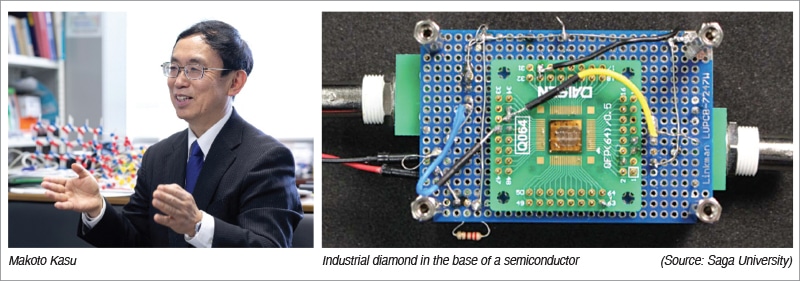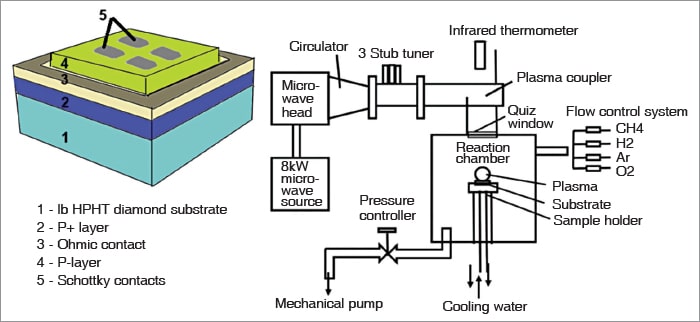With unmatched thermal conductivity and a wide bandgap, diamonds are poised to meet the increasing demand for more efficient, high-performance devices.

Diamonds, long symbols of love, power, and wealth, are formed in Earth’s mantle and are prized for their exceptional hardness, brilliance, and rarity. These qualities not only make them valuable as gemstones but also essential in various industrial applications, including cutting tools, abrasives, heat sinks, optical components, drilling, and machinery.
Their high refractive index and transparency further enhance their value in high-performance lenses and laser windows.
Beyond their aesthetic appeal, diamonds have garnered attention in the semiconductor industry for their unique properties. Lab-grown synthetic diamonds, produced primarily through microwave plasma chemical vapour deposition (MPCVD), share the same chemical and physical characteristics as natural diamonds while addressing many ethical and environmental concerns.
The potential of diamonds to surpass materials like silicon carbide (SiC) and gallium nitride (GaN) in semiconductor applications has driven significant research worldwide. Universities and research institutions in the US, Europe, and Asia are at the forefront of this promising development.
Table of Contents
First Diamond n-channel MOSFET
The first power circuit containing synthetic diamond semiconductors has been developed by a Japanese university research team. After exploring the theory that diamond semiconductors can outperform silicon and other materials currently used, the team at Saga University, led by Makoto Kasu, began investigating diamond semiconductors.
Check here: World’s First N-Channel Diamond MOSFET
Saga University’s pioneering research has produced promising results that could pave the way for the use of diamond semiconductor technology in such applications.
With over 190 hours of continuous use, Kasu’s power circuit demonstrated stability without deterioration, switching in less than 10 nanoseconds. The properties of diamond as a semiconductor make it a potential material for future electronic components.
This expands the range of operating conditions for CPUs and removes the need for direct cooling.
The researchers constructed a transistor using two ‘phosphorus-doped diamond epilayers.’ Phosphorus doping—basically, the addition of the element to the layers—is required to increase conductivity.
In a traditional chip, the silicon-based layer would be replaced with this n-channel layer, which transports free electrons. Through this process, enough electrons flow to bridge two ends of a gate, called ‘the source’ and ‘the drain,’ which closes the circuit to indicate a 1 instead of a 0.
The team heavily doped the second, positive layer and lightly doped the first, negative layer with phosphorus. The use of the second diamond layer significantly reduced source and drain contact resistance.
The researchers then added aluminium trioxide, 30 nanometres thick, as an insulator after annealed titanium ‘source’ and ‘drain’ connections were formed on the top, heavily doped layer. The result was the first functional n-channel MOSFET transistor made with a diamond.
The transistor was subjected to various tests to evaluate its conductivity performance. The researchers reported that the n-type diamond MOSFETs demonstrated high field-effect mobility of around 150cm²/V/sec at 573K—the highest among all n-channel MOSFETs based on wide-bandgap semiconductors—indicating strong conductivity and stability at high temperatures.
Related companies are gaining more attention due to the potential for diamond semiconductors to accelerate commercialisation.
Notable pioneers (Diamond Semiconductor Companies)
Adamant Namiki Precision Jewel Co, Ltd (Ad-Na)
A Japanese company specialising in producing high-quality diamond wafers essential for semiconductor device fabrication
Saga University
This Japanese university has extensively studied diamond semiconductors and developed cutting-edge devices with record-breaking output power
Element Six
A leader in the creation and synthesis of synthetic diamonds, particularly for electronic devices
Cree
A semiconductor manufacturer that has investigated diamond substrates for high-power electronics
Power semiconductors are the engine driving the growth of more electric economies, managing and modifying electricity flows. Their impact is essential for system power, compactness, and efficiency. Thus, they are indispensable for widespread electrification and the decarbonization of entire economic sectors.
Emerging ‘wide bandgap’ diamond semiconductors are considered the ultimate power semiconductor in Japan, Europe, and the US, making them the preferred material for a new generation of power management components.

Diamond Semiconductor by MPCVD










